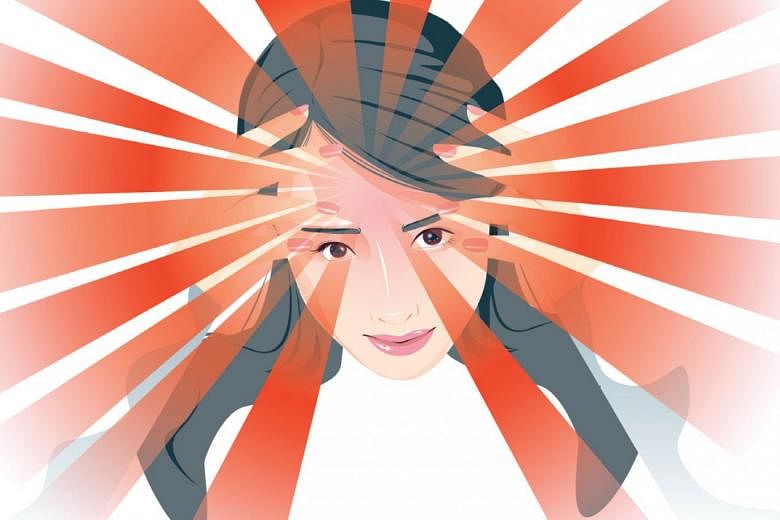In recent years, more and more people have been seeking treatment for headaches - many caused by lifestyle factors.
Mrs Chong (not her real name), a fund manager in her 40s, consulted me after experiencing mild daily headaches, followed by a severe throbbing headache over the forehead and behind the eyes for about two weeks.
Her headaches were associated with heart palpitations and sweaty palms. She could not focus well during meetings.
She has hypertension. She spends about 10 hours daily on digital devices and goes on monthly work trips to Europe.
These are all possible risk factors for headaches. The heavy usage of digital devices will cause tension to build up in various parts of the body, especially the neck muscles.
Headaches are prevalent among professionals who often travel across different time zones. This is due to the lack of rest and the high altitude experienced.
It's not surprising that headaches are the most common and frequent pain suffered by Singaporeans, according to a recent Nurofen-commissioned health survey conducted by DataSpring.
About 75 per cent of those who are prone to headaches get them at least once a month, while 25 per cent of them get them once a week.
Most episodes were reported to last between one and three hours - resulting in work productivity loss of up to 40 days annually.
Mrs Chongwas treated with painkillers and hypertension medications. As a precaution, I arranged a magnetic resonance imaging (MRI) scan, which can detect a variety of brain conditions.
-
75 %
People prone to headaches who get them at least once a month.
25 %
People prone to headaches who get them once a week.
Her scan results showed some white spots in the white matter in both lobes of the brain.
Although there are many causes for these "white matter lesions", doctors are increasingly seeing an association between these lesions and migraines.
NOT ALL HEADACHES ARE THE SAME
Headaches are usually classified by the source of the pain.
Primary headaches are usually caused by lifestyle factors and arise as the body sends electrical signals to the brain to inform it of its stress.
When ignored, this continuous bombardment causes the signals to disperse widely, activating and sensitising not only pain pathways but also pathways responsible for automatic functions, sleep-wake cycles, emotions and mood.
This stress can be caused by factors such as long flights, high altitudes, heavy usage of digital devices, poor posture and lack of sleep. Hormonal changes during periods can also play a part.
Secondary headaches usually come with alarming symptoms, including fever, vomiting, nausea and numbness on one side of the body. Such headaches are a result of structural abnormalities like a blood clot, brain tumour or brain swelling. Sufferers should consult a doctor immediately.
In Singapore, people commonly suffer from tension headaches and migraines. Tension headaches are usually felt in a widespread area or all over the head. Some patients describe them as a band-like distribution of pain stretching from the front to the back of the head.
Migraines come with a throbbing pain and are usually felt on one side of the head, similar to a string being pulled taut and then released.
The best way to manage headaches is to prevent them. If you have identified a trigger, modify your lifestyle to avoid it.
For example, neck strain can be eased with exercise and physiotherapy. Exercising causes the brain to release endorphins, a natural pain reliever.
Unfortunately, not all triggers are identifiable or avoidable, hence the need for medication.
Over-the-counter medicines such as ibuprofen, paracetamol and aspirin can give temporary relief.
Ibuprofen and aspirin are analgesics with anti-inflammatory properties (NSAIDS), which are effective if the migraine is associated with inflammation elsewhere in the body.
Paracetamol is most effective if the patient has only a mild headache and fever and no other symptoms. Ultimately, which painkiller is chosen depends on the type of pain.
•Dr Mathew Tung is a consultant neurosurgeon at Pacific Healthcare Specialist Centre

